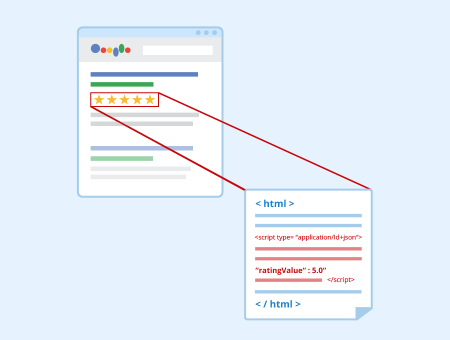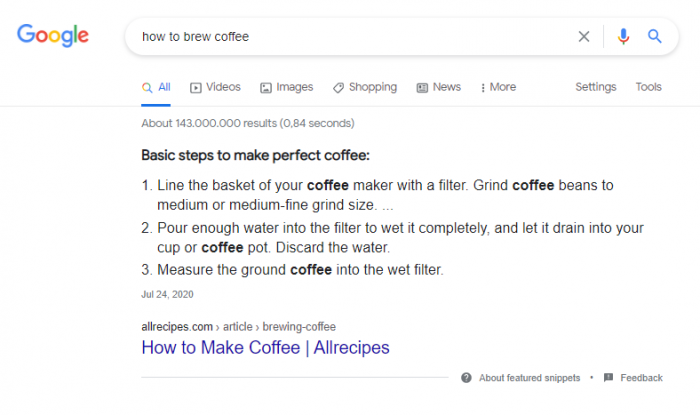Definition

The term structured data refers to all types of data that are structured or organized in any form. For example, in content management systems, individual pages are dynamically generated from data stored in a structured database. However, embedding the data in a web page’s HTML code makes it difficult for search engines like Google to understand and use it. For this reason, structured data is used to help search engines understand the information.
Application of structured data
Today the SERPs (search engine result pages) of Google and other search engines answer user requests without them having to click on the actual results. In order to provide this information, search engines use structured data. Examples of structured data include detailed event information, full addresses, reviews, or how-tos where all materials and preparation steps are listed in search results (see figure below). This way, search engine users get the information they are looking for without having to visit the website the information came from.

Screenshot with instructions on how to brew coffee in the SERPS of google.com
Structured data – Syntax and vocabularies for implementation
Search engines usually support three different syntaxes for implementing structured data in an HTML page: JSON-LD, microdata, and RDFa.
JSON-LD is the abbreviation for “JavaScript Object Notation for Linked Data”. It is an implementation format for structuring data analogous to microdata and RDFa. Typically, JSON-LD is implemented using schema.org vocabulary. JSON-LD is used by the Google Knowledge Graph and recommended by Google for the implementation of structured data. JSON-LD is a relatively new format that comments on a web page’s elements and structures data.
Microdata is part of the WHATWG HTML standard and is used to nest metadata within existing content on web pages. Search engines, web crawlers, and browsers can extract and process microdata from a web page. Microdata uses supporting vocabulary to describe elements and name-value pairs and to assign values to properties.
In HTML5, RDFa provides an extension to support linked data. RDFa adds HTML tag attributes to the content visible to users. The attributes are used to identify these contents for search engines. RDFa can be used both in the body and head area of an HTML page.
In general, two vocabularies are used together with these syntaxes to mark the data: microformats.org and schema.org. Schema.org is a joint initiative launched in 2011 by Google, Yahoo!, Yandex and Bing. The aim of this initiative is to standardize the markup of data within web pages.
Implementation of structured data on a web page
The correct implementation of structured data is important for SEO and can be done in several ways. For CMS like WordPress, Drupal, Typo3 or Joomla, there are plugins available that do the markup automatically.
Another possibility is Google’s own “Structured Data Markup Helper”. After accessing a URL or pasting HTML code, all necessary information for the respective data type can be entered in the Markup Helper. The tool provides a list of all possible values for each element, in which all mandatory values are marked. It then generates the HTML code using Google’s structured data. The output format is either JSON-LD or microdata. You can download or copy the code and paste it into your website.
Last but not least, structured data can be manually inserted into a website’s HTML code. However, this method is error-prone and requires programming skills.
Importance for SEO
Google, Bing, and other search engines encourage webmasters to use structured data in SEO and provide benefits for sites where structured data is correctly implemented. Some of these benefits include search result improvements and content-specific features such as presenting search results as rich search results. These are rich snippets with images, rating stars, or other additional excerpts from the site’s content. They can also be displayed as rich cards on mobile devices and in Google’s carousel or knowledge graph.
The advantages for SEO generally result from the fact that extended search results are more visually appealing for users. This usually improves the click-through rate (CTR) and generates additional traffic. An improved click-through rate can also indirectly improve rankings and SEO, as the CTR is an important signal for search engines regarding user behavior.
Testing the markup with Google’s Search Console and structured data testing tool
Before you publish a structured data web page, you should verify the correct implementation of the markup to ensure that the data can be read and used by Google. Google provides a free structured data testing tool for verification. The test simply requires you to enter your website’s URL to analyze the page, display all marked up data and receive information about errors and warnings.
Google’s Search Console is another way to check this. It displays all structured information found on a website on the structured data page. It also indicates whether errors in the markup were found that could prevent rich snippets from appearing in search results.
In summary: Structured data FAQs
What are examples of structured data?
Examples of structured data are addresses, reviews, event information, or recipes.
What is structured data used for?
Structured data helps search engines to display information relevant to a search query within the SERPs. That means users do not have to perform additional clicks.
How do you integrate structured data in your website?
If you’re using a CMS, you can just use plugins to integrate structured data. Another tool is Google’s Structured Data Markup Helper.
How can you verify your structured data?
There are multiple tools available to verify your structured data before releasing it to the public. One option is Google’s Structured Data Tool.
Related links
- Seobility Rich Snippets Guide: Everything You Need To Know In 2021
- https://developers.google.com/search/docs/guides/intro-structured-data
- https://backlinko.com/hub/seo/snippets
